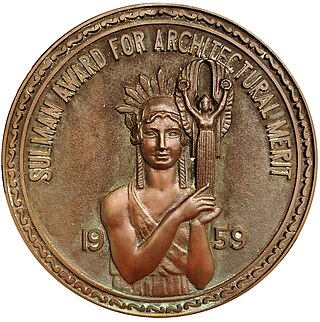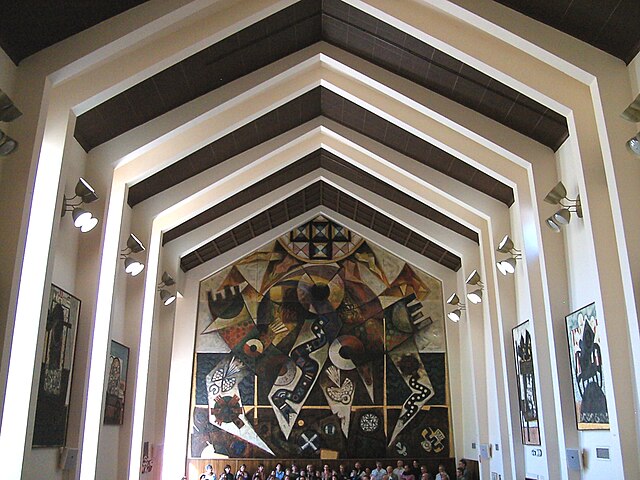Top Qs
Timeline
Chat
Perspective
Sir John Sulman Medal
Annual award for public buildings in New South Wales From Wikipedia, the free encyclopedia
Remove ads
The Sir John Sulman Medal for Public Architecture is an architectural award presented by the New South Wales chapter of the Australian Institute of Architects since 1934.[1] The medal is sometimes referred to as the Sulman Award and now recognises excellence in public buildings in either New South Wales or in the Australian Capital Territory. Before the advent of the Wilkinson Award in 1961, it was on occasion presented to residential housing projects.
Remove ads
Background
Summarize
Perspective
Sir John Sulman
The medal is presented in memory of the Australian architect Sir John Sulman (29 August 1849–18 August 1934).[1] Sulman was born in Greenwich, England, and emigrated to Sydney in 1885. From 1921 to 1924 he was chairman of the Federal Capital Advisory Committee and influenced the development of Canberra. Late in his life, Sulman personally established a fund to be administered by the Institute of Architects, to support the annual awarding of the Sulman Medal for the design of a building demonstrating exceptional architectural merit.[2] The first award was presented in June 1934 shortly before Sulman's death.
Medal design
The medal design was completed in 1934 by Rayner Hoff (1894—1937), sculptor and teacher, well known for his architectural scaled sculptures in Sydney's Anzac Memorial in Hyde Park.[3] The circular bronze plaque has the text 'Sulman Award for Architectural Merit' on its perimeter, the year awarded, and a female figure holding a smaller winged female figure. The central figure is a stylised classical female in draped garments wearing a radiated headdress, reminiscent of classical depictions of deities or personifications such as Justice, Athena, or Liberty, symbolising cultural enlightenment, reason, and civic virtue. Her left arm cradles a sculptural figure, and her right hand gestures toward it, indicating reverence or presentation. The object she holds is a trophy or miniature statue, depicting a smaller winged or robed figure standing with arms raised. This smaller figure resembles traditional representations of Victory (Nike) or a muse, which often symbolise achievement, excellence, and inspiration.

Remove ads
History of the Award
Summarize
Perspective
Sulman was an enthusiastic about town planning, and it was intended that the Medal was for "a building of exceptional merit that contributed to the streetscape".[4] This interest in the greater urban environment and the relationship of the building to the public domain parallels the earlier Royal Institute of British Architects Street Architecture Medal instigated in 1923, and the RVIA Street Architecture Medal in Melbourne that began in 1929, later to be known as the Victorian Architecture Medal.
1941 Award
In April 1941 the Council of the New South Wales Chapter of the Royal Australian Institute of Architects invited nominations of buildings for the 1940 Sir John Sulman Medal. The appointed jury was M.E. Herman, ARAIA (Architect), G.H.B. McDonnell, ARAIA (Architect and 1940 winner), John D. Moore, ARAIA (Architect and 1937 winner), Henry Pynor, ARAIA (Architect), Frank Medworth, RBA (Painter), R. Haughton James (Art Critic) and Will Ashton (Director, National Art Gallery). Nominated buildings needed to have been completed during the five years ending 31 December 1940. Categories for consideration included: 1. Public and Monumental — Government Buildings, Town Halls, Art Galleries, Railway Stations, Hospitals, etc. 2. Educational and Ecclesiastical — Schools, Churches, Convents, etc. 3. Commercial and Industrial — Office Buildings, Warehouses, Factories, etc. 4. Recreational— Theatres, Sporting Buildings, etc. 5. Domestic and Residential — Homes, Flat Buildings, etc.[5]
1950 Award
In the 1950 Year Book of the Royal Australian Institute of Architects, the Sir John Sulman Medal and Diploma was defined as being "awarded annually for a building of exceptional merit in one of the following classes: (1) Public and Monumental, (2) Educational and Ecclesiastical, (3) Commercial and Industrial, (4) Recreational, (5) Domestic and Residential. The building must have been erected in New South Wales within the previous five years and must be readily accessible and visible. The Jury comprises four Architects, one Painter, one Art Critic, and the Director of the National Art Gallery."[6]
Remove ads
List of Sulman Medal Winners
Remove ads
See also
References
Wikiwand - on
Seamless Wikipedia browsing. On steroids.
Remove ads





























